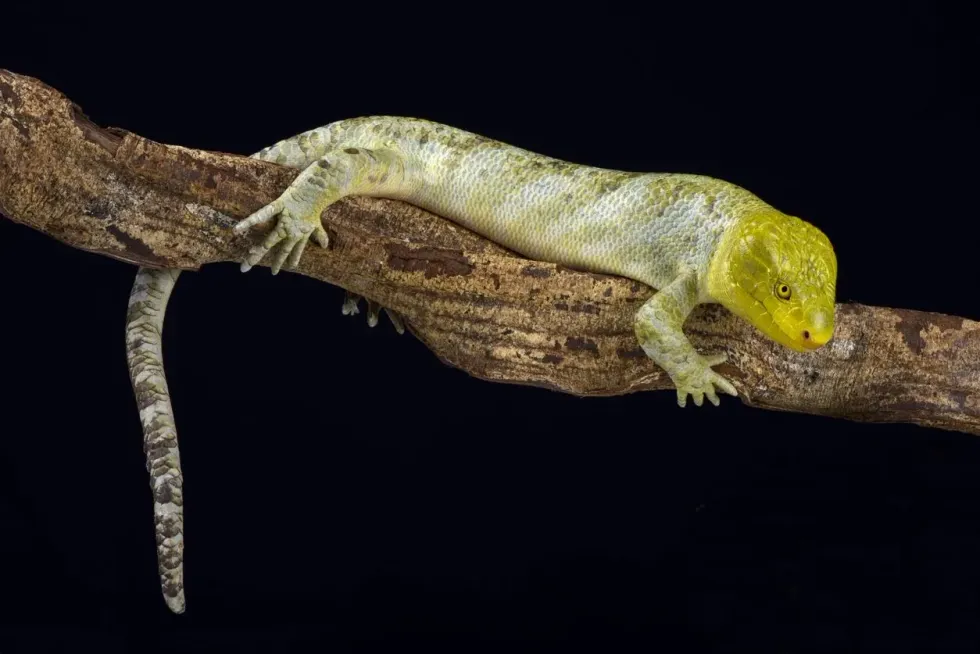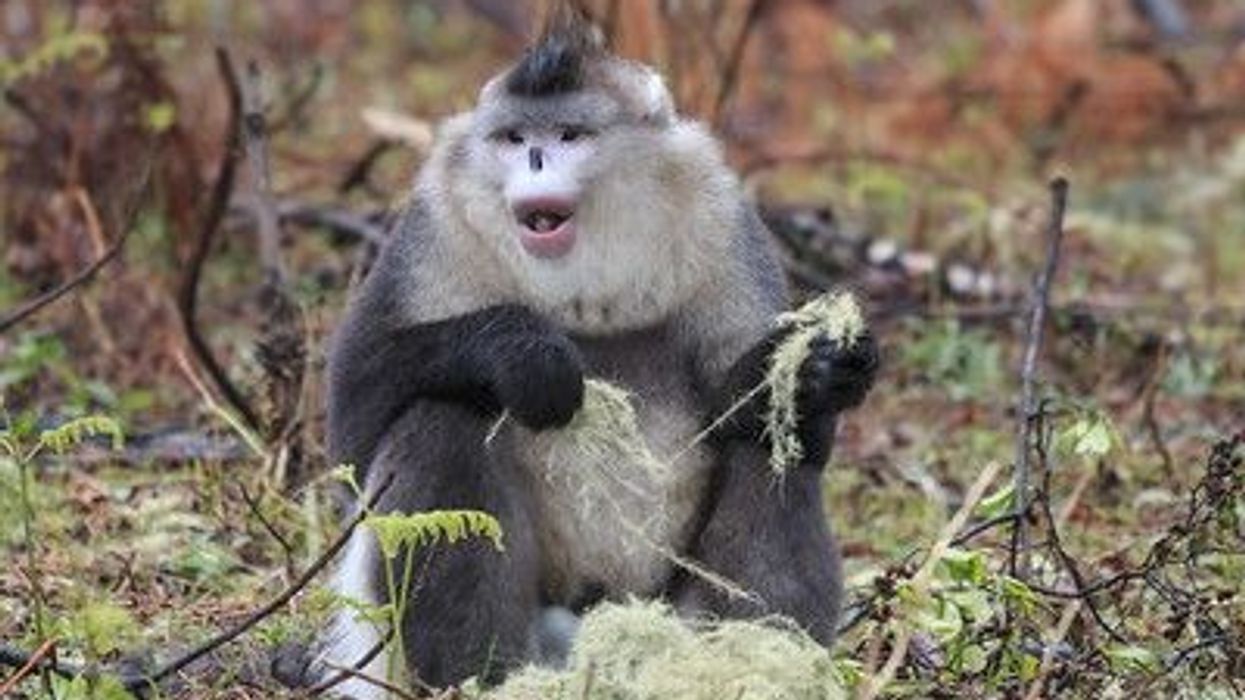The monkey-tailed skink (Corucia zebrata) stands apart from other skink species in various ways. It's the only skink species with a prehensile tail and is the king of all skinks in size.
This skink, also known as the Solomon Islands skink is the largest and the only one that is completely herbivorous. They are commonly known as the prehensile-tailed skink, zebra skink, Solomon Island skink, and giant skink. The former part of their common name 'prehensile-tailed' originates from 'prehendere', a Latin verb, that implies 'to grasp or seize'.
These lizards have a prehensile tail as their name suggests, also called a 'monkey tail'. This tail helps them when climbing tree branches in their natural habitat.
These giant lizards are found across the Solomon Islands. Their color varies between shades of light yellow and green and their diet in the wild comprises leaves, flowers, fruit, and growing shoots. To know more about their habitat, diet, and behavior, and much more about these fascinating reptiles, we suggest you keep reading!
If you like reading about the monkey-tailed skink, we are sure you'd love to read these cool facts about the frilled lizard and the blue-tongued skink!
Monkey-Tailed Skink Interesting Facts
What type of animal is a monkey-tailed skink?
The prehensile-tailed Skink (Corucia zebrata) is a giant lizard of the family Scincidae and the genus Corucia. They are the only herbivorous skinks and have a diet that comprises flowers, leaves, growing shoots, and fruits.
What class of animal does a monkey-tailed skink belong to?
These prehensile-tailed skinks belong to the class Reptilia.
How many monkey-tailed skinks are there in the world?
The exact population of these Solomon Island skink lizards is not yet known. However, this species of skink is protected under Appendix II of the Convention on International Trade in Endangered Species (CITES) for their conservation.
Where does a monkey-tailed skink live?
The prehensile-tailed skink lives in the rainforest. They are animals that dwell in forested areas. Only the Solomon Islands, an extensive group of islands in the Pacific Ocean, northeast of Australia, is home to prehensile-tailed skinks. These arboreal animals are indigenous to these islands.
What is a monkey-tailed skink's habitat?
These skinks with prehensile tails are completely arboreal, barely moving on the ground. They've adjusted effectively to their daily existence in the branches and holes of trees. They support themselves by grasping tree branches with their large, prehensile tails. Prehensile-tailed skinks hide between branches and tree holes throughout the day.
They are energetic and lively early in the morning, early in the evening, and occasionally at night. They eat leaves and fruit as they glide slowly through the trees. The Solomon Island creeper plant is one of their favorites.
Who do monkey-tailed skinks live with?
Prehensile-tailed skinks are timid and solitary, yet they are also very gregarious for reptiles. One or maybe more bonded pairs of adults, as well as many other more familiar or unfamiliar skinks, establish social clusters.
How long does a monkey-tailed skink live?
These prehensile-tailed skinks (Corucia zebrata) can live anywhere between 25-35 years, sometimes even more!
How do they reproduce?
These reptiles are one of the very few species of reptiles that can produce live offspring. The female prehensile-tailed skink can give birth to one or two offspring, rarely three.
This reptile's gestation period lasts for seven to eight months. Young prehensile-tailed skinks are significantly large; they are nearly a third the size of their mother.
Male and female skinks of this species care for their young together. Offsprings of the Solomon Island skink reside with their family and in groups of this species until they are mature to start their very own family groups.
What is their conservation status?
The conservation status of the prehensile-tailed skink has not been evaluated yet. However, these animals face threats.
On the Solomon Islands, they are reportedly threatened in the wild because of habitat destruction and an over-collection of this species for the pet trade. Appendix II of the Convention on International Trade in Endangered Species (CITES) protects prehensile-tailed skinks and exporting them from the Solomon Islands is prohibited.
Deforestation in the Solomon Islands is also accelerating due to agriculture, putting pressure on species like the prehensile-tailed skink.
Monkey-Tailed Skink Fun Facts
What do monkey-tailed skinks look like?
This species of skink has a prehensile tail of a long length, commonly referred to as a monkey tail, and a wide head comprising a strong pair of jaws. They have sharp, pointed teeth.
They can grow up to 32 in (81 cm) in length while weighing between the range of 14-28 oz (396-793 g).
The body of these arboreal reptiles is cylinder-shaped and comprises short legs and a prehensile tail. Their skin has scales all over it that are green colored and they also gave brown and black colored splotches.
How cute are they?
This species can be considered adorable because of its green scaly skin that has spots all over it. However, to some, they might be a little creepy to look at.
How do they communicate?
Except during the mating season when they use pheromones, these reptiles have few accounts of conversing with each other.
How big is a monkey-tailed skink?
An adult prehensile-tailed skink can grow as long as 32 in (81 cm) towards the tip of the tail beginning from its nose. The prehensile tails of these animals account for more than half of their total length! These prehensile-tailed skinks are eight times the size of garden skinks!
How fast can a monkey-tailed skink run?
The speed of the prehensile-tailed skink species is not yet known. However, we do know that they are fast climbers, and can climb up a tree very fast. The top speed of the skink species overall is 65 mph (104 km/hr).
How much does a monkey-tailed skink weigh?
The prehensile-tailed skink weighs anywhere in the range of 14-28 oz (396-793 g).
What are the male and female names of the species?
There are no specific names for males and females in the prehensile-tailed skink species.
What would you call a baby monkey-tailed skink?
A baby of the prehensile-tailed skink, Corucia zebrata, is referred to as offspring, juvenile or young.
What do they eat?
These Solomon Island skinks have a diet that comprises flowers, leaves, growing shoots, and fruits in the wild. Snakes, birds of prey, and rats may prey on prehensile-tailed skinks.
People who catch these arboreal animals illegally for the pet trade also pose a threat. When the Solomon Island skink is disturbed, this usually calm and slow-moving reptile will hiss and bite to defend itself.
Are they poisonous?
No, these reptiles are not poisonous.
Would they make a good pet?
These giant skinks are challenging to be kept as pets. A big enclosure and constant heat for digestion are required for these animals if kept in captivity. Monkey-tailed skink care includes a healthy and nutritious diet along with regular baths in tepid water which prevents stress.
Did you know...
Corucia zebrata was the name given to the Solomon Islands skink by John Edward Gray in the year 1855.
How much are monkey-tailed skinks?
They have a price range of $1,249-1,749. Due to significant deforestation in their natural environment, prehensile-tailed skinks have been classified as endangered. As a result, it's critical to ensure that the pet reptile is bred in captivity in the USA rather than being captured in the wild.
Monkey-tailed skinks and their babies
The offsprings of skinks reside with their family group for at least six to 12 months. They eat the placental sac after their birth for the initial two days.
These babies consume the feces of their parents to acquire the very important 'microflora' that helps them with the digestion process. They separate when they become mature enough to start their family groups.
Here at Kidadl, we have carefully created lots of interesting family-friendly animal facts for everyone to discover! Learn more about some other reptiles from our monitor lizard facts and iguana facts pages.
You can even occupy yourself at home by coloring in one of our free printable Monkey-tailed skink coloring pages.










